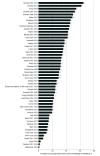Assessment of Knowledge of HIV/AIDS and Association With Socioeconomic Disparities Among Young Women in Low- and Middle-Income Countries, 2003 to 2018
- PMID: 33481034
- PMCID: PMC7823222
- DOI: 10.1001/jamanetworkopen.2020.35000
Assessment of Knowledge of HIV/AIDS and Association With Socioeconomic Disparities Among Young Women in Low- and Middle-Income Countries, 2003 to 2018
Erratum in
-
Error in Byline.JAMA Netw Open. 2021 Feb 1;4(2):e213317. doi: 10.1001/jamanetworkopen.2021.3317. JAMA Netw Open. 2021. PMID: 33635320 Free PMC article. No abstract available.
Abstract
Importance: Knowledge of HIV/AIDS among the younger population is crucial for long-term control. Little research has been done on which groups of young women (aged 15-24 years) in low- and middle-income countries (LMICs) have been left behind with respect to obtaining this knowledge.
Objective: To provide an up-to-date assessment of the levels of and changes in knowledge of HIV/AIDS and its associations with socioeconomic disparity among young women in LMICs.
Design, setting, and participants: This cross-sectional study used nationally representative Demographic and Health Surveys with available data on HIV/AIDS knowledge in 51 LMICs between 2003 and 2018. The final data set contained 282 757 young women. For 40 LMICs with multiple surveys available, we examined changes in knowledge and socioeconomic disparities. Analyses of the survey data were conducted between December 1, 2019, and July 31, 2020.
Main outcomes and measures: The percentage of young women who were able to (1) correctly identify the 2 major ways of preventing the sexual transmission of HIV, (2) reject the 2 most common local misconceptions about HIV transmission and (3) know that a healthy-looking person can transmit HIV. The level of and changes in young women's knowledge of HIV/AIDS as well as knowledge disparities by residential area, wealth status, and level of education on the aggregate and country levels were assessed.
Results: Of a total of 282 757 young women from 51 LMICs, 29.3% (95% CI, 24.1% to 34.5%) reported having knowledge of HIV/AIDS in the latest years, ranging from 1.0% (95% CI, 0.7% to 1.3%) in Afghanistan in 2015 to 64.9% (95% CI, 63.3% to 66.5%) in Rwanda in 2014 to 2015. Those living in rural areas, living in households in the lowest income quintile, or with low levels of education reported less knowledge about HIV/AIDS than their counterparts (-12.8 [95% CI, -10.6 to -14.9] percentage points; -21.8 [95% CI, -18.3 to -25.3] percentage points; and -19.4 [95% CI, -16.6 to -22.2] percentage points, respectively). Among the 40 countries that had undertaken at least 2 surveys during the period, the surveys indicated that there was a significant increase in knowledge of HIV/AIDS among young women in 24 countries (60.0%), but a significant decrease in 10 countries (25.0%). Less than half of countries experienced significant reductions in disparities associated with residential area (8 countries [20.0%]), wealth (5 countries [12.5%]), or education (17 countries [42.5%]).
Conclusions and relevance: This cross-sectional study of women in 51 LMICs found low levels and large gaps in knowledge of HIV/AIDS between groups, suggesting that future HIV-prevention campaigns should emphasize providing easily accessible information to socioeconomically disadvantaged groups.
Conflict of interest statement
Figures
Similar articles
-
Explaining inequity in knowledge, attitude, and services related to HIV/AIDS: a systematic review.BMC Public Health. 2024 Jul 8;24(1):1815. doi: 10.1186/s12889-024-19329-5. BMC Public Health. 2024. PMID: 38978024 Free PMC article.
-
HIV/AIDS knowledge, women's education, epidemic severity and protective sexual behaviour in low- and middle-income countries.J Biosoc Sci. 2007 May;39(3):421-42. doi: 10.1017/S0021932006001465. Epub 2006 Jul 20. J Biosoc Sci. 2007. PMID: 16854252
-
Educational and wealth inequalities in tobacco use among men and women in 54 low-income and middle-income countries.Tob Control. 2018 Jan;27(1):26-34. doi: 10.1136/tobaccocontrol-2016-053266. Epub 2016 Nov 24. Tob Control. 2018. PMID: 27885168
-
Why do some women know more? An exploration of the association of community socioeconomic characteristics, social capital, and HIV/AIDS knowledge.Women Health. 2013;53(7):669-92. doi: 10.1080/03630242.2013.822456. Women Health. 2013. PMID: 24093449
-
Human immunodeficiency virus infection and AIDS in east Africa: challenges and possibilities for prevention and control.East Afr Med J. 1996 Jan;73(1):13-9. East Afr Med J. 1996. PMID: 8625855 Review.
Cited by
-
Explaining inequity in knowledge, attitude, and services related to HIV/AIDS: a systematic review.BMC Public Health. 2024 Jul 8;24(1):1815. doi: 10.1186/s12889-024-19329-5. BMC Public Health. 2024. PMID: 38978024 Free PMC article.
-
Understanding Comprehensive Sexuality Education: A Worldwide Narrative Review.Cureus. 2024 Nov 29;16(11):e74788. doi: 10.7759/cureus.74788. eCollection 2024 Nov. Cureus. 2024. PMID: 39737310 Free PMC article. Review.
-
Evaluating knowledge about HIV and discriminatory attitudes among Pakistani women of reproductive age using 2017-18 Demographic Health Survey data.Sci Rep. 2023 Oct 19;13(1):17849. doi: 10.1038/s41598-023-45117-z. Sci Rep. 2023. PMID: 37857793 Free PMC article.
-
Persistence on oral pre-exposure prophylaxis (PrEP) among female sex workers in eThekwini, South Africa, 2016-2020.PLoS One. 2022 Mar 15;17(3):e0265434. doi: 10.1371/journal.pone.0265434. eCollection 2022. PLoS One. 2022. PMID: 35290421 Free PMC article.
-
The knowledge mapping of HIV/AIDS in Indonesians living on six major islands using the Indonesian version of the HIV-KQ-18 instrument.PLoS One. 2023 Nov 10;18(11):e0293876. doi: 10.1371/journal.pone.0293876. eCollection 2023. PLoS One. 2023. PMID: 37948410 Free PMC article.
References
-
- The Joint United Nations Program on HIV/AIDS (UNAIDS) UNAIDS data 2019. Updated December 4, 2019. Accessed August 23, 2019. https://www.unaids.org/en/resources/documents/2019/2019-UNAIDS-data
-
- The Joint United Nations Programme on HIV/AIDS (UNAIDS) Global AIDS monitoring 2020: indicators for monitoring the 2016 political declaration on ending AIDS. Published December 24, 2019. Accessed December 11, 2020. https://www.unaids.org/en/resources/documents/2019/Global-AIDS-Monitoring
-
- United Nations The Millennium Development Goals report 2015. Accessed December 5, 2019. https://www.un.org/millenniumgoals/2015_MDG_Report/pdf/MDG%202015%20rev%...
Publication types
MeSH terms
LinkOut - more resources
Full Text Sources
Other Literature Sources
Medical


